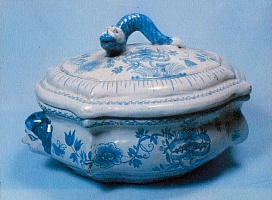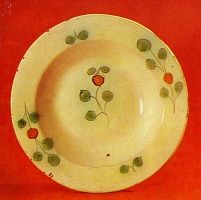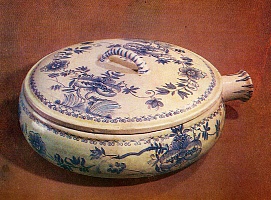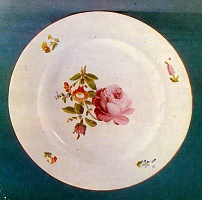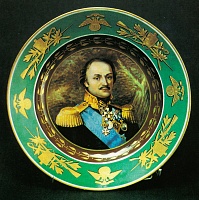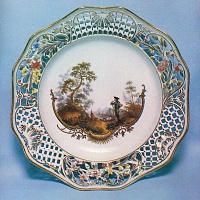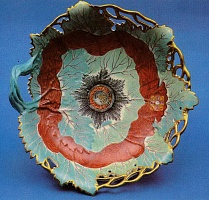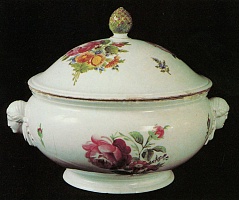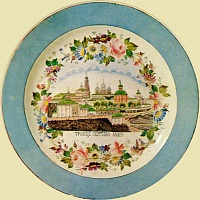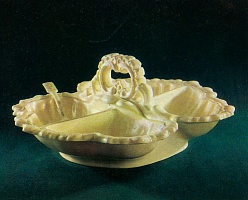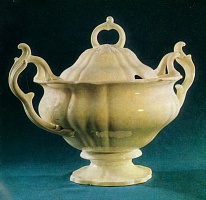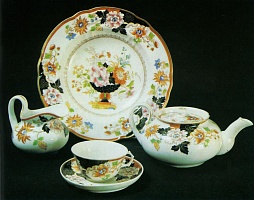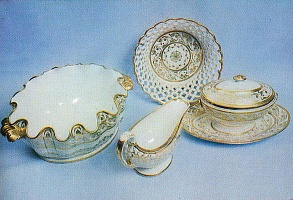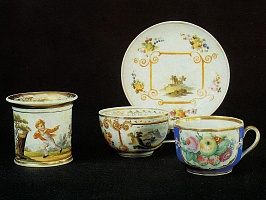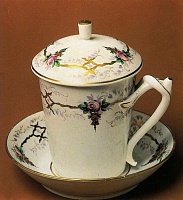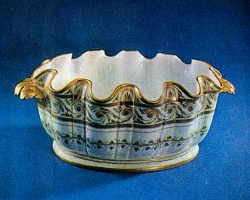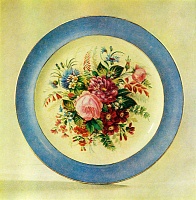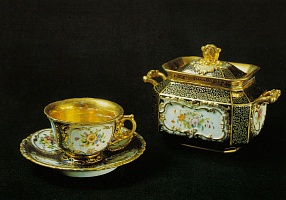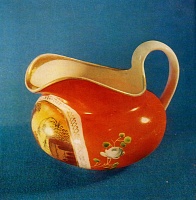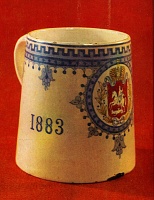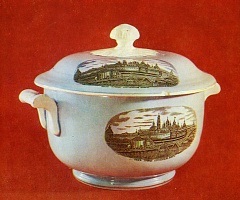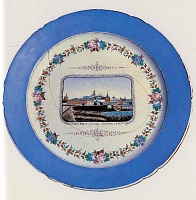The 18th - 19th century ceramics
In 1930, the Museum acquired A. Alexandrov’s collection, comprising quite a number of porcelain and faience items. The collection was considerably supplemented by the expeditions, organized between 1978 and 1985 for systematic investigation of the districts in the Moscow region, where ceramics was traditionally produced.
The earliest exhibits date back to the mid-18th century—the time when Baroque style prevailed. The Museum collection includes unique majolica items, manufactured at the first Russian plant, opened in Moscow in 1724. It belonged to Afanasy Kirillovich Grebenshchikov. Grebenshchikov works equaled to European products and were highly appreciated at that time. They were characterized by large sizes, yellowish-pink material, bluish-white enamel, painting on enamel, reminding of the 18th century Chinese and West European faience and majolica. These articles were used in everyday life of higher society.
Since the mid-18th century majolica tableware, popular in different social groups, was made in the ceramic workshops of the Gzhel plant situated near Moscow. At first they imitated the products of Grebenshchikov’s Factory. The rapid development of high-quality ceramics was determined by the high achievements of folk pottery. Several articles of scarcely surviving ordinary Gzhel tableware are preserved in our Museum.
In 1744, the first Russian porcelain factory was founded. It was called the Imperial Porcelain Manufactory. In 1746-1747, M. Lomonosov’s associate D. Vinogradov discovered the secret of porcelain and worked out the production technology. Producing mainly sets for the royal court the Imperial Manufactory made cheaper "ordinary" articles, as well. Presented in the Museum collection, they are distinguished by warm white porcelain, soft shining glaze and pure colors.
The Museum also preserves several plates with monograms of the 18th – early 19th century Russian tsars. At the Meissen porcelain factory in Germany the so-called “Hunter Set” was produced to the order of Catherine II for the Empress’s hunting lodge in Oranienbaum. In 1850-1880, the Imperial plant produced missing items on the models of the surviving articles.
Porcelain gradually turned from luxury to ordinary belongings in different layers of the society. In the 19th century, its production rapidly developed. The first private manufactory was opened by Francis Gardner in 1766 in Verbilki village near Dmitrov in the vicinity of Moscow. The most important 18th century products were four "order sets", commissioned by the royal court for the annual ceremonial receptions of the persons awarded with the highest state orders of St. Andrew, St. George, St. Alexander Nevsky, St.Vladimir.
These sets included a lot of various items decorated with the order emblems and ribbons. Some of them are represented in the Museum's collection. Along with contracted luxurious products, the Gardner factory began to produce articles for public at large. They are comprehensively represented in the Museum collection. These products were mainly decorated with flowers: a large bouquet ( a flower) was painted in the center and small flowers on the board. Bright painting and pure colors resembled Russian folk ceramics.
Faience was a wonderful sphere of ceramics that was widely used in the 19th
century. Faience items were manufactured practically by all plants. F. Gardner’s Manufactory started to produce them in the 1820s – 1830s. In the middle and second half of the 19th
century, faience replaced previous pottery and majolica at the Gzhel handicraft enterprises. This white soft material was cheaper than porcelain, so it was universally required.
The Museum collection contains a large number of faience utensils, decorated with the so-called "printing" technique, when the image was stamped on the object mechanically. Several faience dishes represent a view of the Trinity-St. Sergius Lavra or its monogram (TSL). Many factories used both printing and painting, trying to preserve the traditional picturesque ornaments
In the first half of the 19th century, a number of private porcelain factories appeared in Russia. In 1811, the largest plant was founded by A. Popov at the village of Gorbunovo in the Dmitrov district, not far from Sergiev Posad. It produced high-quality porcelain, characterized by a wide variety of forms and expressive painting, suited to every fancy.
The dining set, including peculiar dessert plates looking like squares, rhombs and triangles, is bright and solemn. The gilded ornaments (garlands and wreaths of grape leaves, figured rosettes) and wide strips of wavy stylized floral patterns are painted on the plates, on the bottle and wineglass trays.
The 19th
century Russian porcelain was also associated with the works of numerous small private factories, located mainly in the Gzhel ceramic district, famous for its white clay. They worked out original shapes and painting techniques. The Museum collection includes items made at the manufactories belonging to I. A. Ikonnikov, Kornilov Brothers, V. I. Zhadin, S. I. Maslennikov, Samsonov and Markov Brothers, Khrapunov-Novy and others. Some factories existed for one or two decades. They are represented only by few items.
The cups and saucers, made at the Kvartalny (Fartalny) Enterprise, are richly decorated. Their external surface is covered with architectural views of the Gethsemane skete situated near the Trinity-St. Sergius Lavra. Inside they are almost completely gilded. The laconic combination of the bright background and simple floral motifs is characteristic of the tea set, painted in the studio of Ya. Orlov.
The late 19th - early 20th
century was the time of M. S. Kuznetsov Porcelain Corporation, combining some major porcelain and pottery manufactories. The processing technology was constantly improved. In the 1900s, multi-color printing and airbrush were intensively used. However, along with the widespread mechanical methods, the traditional hand painting was preserved.
The works of Kuznetsov Factories reflected the varied traditions in painting, shape, sets, accumulated in Russian porcelain for two centuries. At that time, porcelain became an integral part of life of both aristocratic and broad democratic groups of the society. Kuznetsov high -quality products gratified various tastes.
Porcelain sculpture
Along with tableware many plants produced porcelain sculpture. It was often created by well-known artists. Thus, the popular figurine “Water Carrier” was made on the model of S.S. Pimenov. The genre statuettes, made at F. Gardner Manufactory, represented folk characters and scenes of folk life: “Collecting Canvas”, “Wife leading drunken husband home”, etc.
In the late 19th
- early 20th century, the remarkable series called “Peoples of Russia” was created on the drawings of Academician N. Georgi at the Imperial Porcelain Manufactory . The whole series was subsequently renewed at the factories of F. Gardner and M. Kuznetsov. It included numerous sculptures authentically depicting the diversity of the ethnographic types.
В конце XIX — начале XX века на заводе Гарднера, а затем М. С. Кузнецова производилась многофигурная серия «Народы России», первоначально созданная на императорском фарфоровом заводе по рисункам академика Н. Георги, и отразившая разнообразие этнографического состава населения России. Скульптуры на крестьянские темы, а также многочисленная серия «Народы России» интересны с точки зрения этнографической достоверности.









